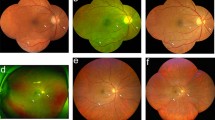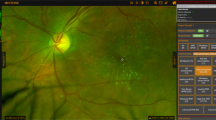Abstract
Purpose
This study compared the efficiency of diabetic retinopathy (DR) diagnosis and differences in the relative visible retinal area among the Early Treatment Diabetic Retinopathy Study (ETDRS) seven-field, ultra-widefield (UWF)-Optos, and UWF-Clarus fundus imaging methods.
Methods
This was a prospective and clinic-based comparative study. All patients underwent three fundus examinations, and all images were graded using the ETDRS severity scale. We compared and analysed the agreement of DR severity and the relative visible retinal area among the three fundus examination methods, and the number and type of lesions outside the ETDRS seven-field (peripheral lesions) between the two UWF imaging methods.
Results
A total of 202 patients (386 eyes) were included. Weighted kappa for the agreement between ETDRS seven-field and blinded Optos images was 0.485; between ETDRS seven-field and blinded Clarus images, 0.924; and between blinded Optos and Clarus images, 0.461. Blinded Clarus showed excellent performance when a ETDRS scale was used for grading the images. The relative visible retinal area for ETDRS seven-field images was 195 ± 28 disc area (DA); single Optos images, 371 ± 69 DA; single Clarus images, 261 ± 65 DA; two-montage Clarus images, 462 ± 112 DA; and four-montage Clarus images, 598 ± 139 DA. The relative visible retinal area was statistically significant between any two of the imaging systems used. In total, 2015 and 4200 peripheral lesions were detected in single Optos and Clarus images, respectively (P < 0.001). These peripheral lesions on two UWF images suggested a more severe DR level in approximately 10% and 12% of eyes, respectively.
Conclusion
UWF-Clarus fundus imaging offers a suitable assessment approach for DR severity; it could improve DR diagnosis and has the potential to replace ETDRS seven-field imaging after additional clinical trials.
This is a preview of subscription content, access via your institution
Access options
Subscribe to this journal
Receive 18 print issues and online access
$259.00 per year
only $14.39 per issue
Buy this article
- Purchase on Springer Link
- Instant access to full article PDF
Prices may be subject to local taxes which are calculated during checkout




Similar content being viewed by others
Data availability
The data that support the findings of this study are not openly available due to reasons of sensitivity and are available from the corresponding author upon reasonable request. Data are located in controlled access data storage at Henan Eye Institute.
References
Stefansson E, Bek T, Porta M, Larsen N, Kristinsson JK, Agardh E. Screening and prevention of diabetic blindness. Acta Ophthalmol Scand. 2000;78:374–85.
Vujosevic S, Aldington SJ, Silva P, Hernandez C, Scanlon P, Peto T, et al. Screening for diabetic retinopathy: new perspectives and challenges. Lancet Diabetes Endocrinol. 2020;8:337–47.
Cheung N, Mitchell P, Wong TY. Diabetic retinopathy. Lancet. 2010;376:124–36.
Szeto SKH, Wong R, Lok J, Tang F, Sun Z, Tso T, et al. Non-mydriatic ultrawide field scanning laser ophthalmoscopy compared with dilated fundal examination for assessment of diabetic retinopathy and diabetic macular oedema in Chinese individuals with diabetes mellitus. Br J Ophthalmol. 2019;103:1327–31.
Natarajan S, Jain A, Krishnan R, Rogye A, Sivaprasad S. Diagnostic accuracy of community-based diabetic retinopathy screening with an offline artificial intelligence system on a smartphone. JAMA Ophthalmol. 2019.
Early Treatment Diabetic Retinopathy Study Research G. Grading diabetic retinopathy from stereoscopic color fundus photographs - an extension of the modified airlie house classification: ETDRS report number 10. Ophthalmology. 2020;127:S99–S119.
Group ETDRSR. Grading diabetic retinopathy from stereoscopic color fundus photographs--an extension of the modified Airlie House classification. ETDRS report number 10. Ophthalmology. 1991;98:786–806.
Group ETDRSR. Early photocoagulation for diabetic retinopathy. ETDRS report number 9. Ophthalmology. 1991;98:766–85.
Aiello LP, Odia I, Glassman AR, Melia M, Jampol LM, Bressler NM, et al. Comparison of early treatment diabetic retinopathy study standard 7-field imaging with ultrawide-field imaging for determining severity of diabetic retinopathy. JAMA Ophthalmol. 2019;137:65–73.
Wessel MM, Aaker GD, Parlitsis G, Cho M, D’Amico DJ, Kiss S. Ultra-wide-field angiography improves the detection and classification of diabetic retinopathy. Retina. 2012;32:785–91.
Sears CM, Nittala MG, Jayadev C, Verhoek M, Fleming A, van Hemert J, et al. Comparison of subjective assessment and precise quantitative assessment of lesion distribution in diabetic retinopathy. JAMA Ophthalmol. 2018;136:365–71.
Silva PS, Cavallerano JD, Sun JK, Soliman AZ, Aiello LM, Aiello LP. Peripheral lesions identified by mydriatic ultrawide field imaging: distribution and potential impact on diabetic retinopathy severity. Ophthalmology. 2013;120:2587–95.
Silva PS, Cavallerano JD, Sun JK, Noble J, Aiello LM, Aiello LP. Nonmydriatic ultrawide field retinal imaging compared with dilated standard 7-field 35-mm photography and retinal specialist examination for evaluation of diabetic retinopathy. Am J Ophthalmol. 2012;154:549–559.e542.
Byberg S, Vistisen D, Diaz L, Charles MH, Hajari JN, Valerius M, et al. Optos wide-field imaging versus conventional camera imaging in Danish patients with type 2 diabetes. Acta Ophthalmol. 2019;97:815–20.
Maruyama-Inoue M, Kitajima Y, Mohamed S, Inoue T, Sato S, Ito A, et al. Sensitivity and specificity of high-resolution wide field fundus imaging for detecting neovascular age-related macular degeneration. PLoS One. 2020;15:e0238072.
Hirano T, Imai A, Kasamatsu H, Kakihara S, Toriyama Y, Murata T. Assessment of diabetic retinopathy using two ultra-wide-field fundus imaging systems, the Clarus(R) and Optos systems. BMC Ophthalmol. 2018;18:332.
Mackenzie PJ, Russell M, Ma PE, Isbister CM, Maberley DA. Sensitivity and specificity of the optos optomap for detecting peripheral retinal lesions. Retina. 2007;27:1119–24.
Kernt M, Hadi I, Pinter F, Seidensticker F, Hirneiss C, Haritoglou C, et al. Assessment of diabetic retinopathy using nonmydriatic ultra-widefield scanning laser ophthalmoscopy (Optomap) compared with ETDRS 7-field stereo photography. Diabetes Care. 2012;35:2459–63.
Gangaputra S, Almukhtar T, Glassman AR, Aiello LP, Bressler N, Bressler SB, et al. Comparison of film and digital fundus photographs in eyes of individuals with diabetes mellitus. Invest Ophthalmol Vis Sci. 2011;52:6168–73.
Group ETDRSR. Fundus photographic risk factors for progression of diabetic retinopathy. ETDRS report number 12. Ophthalmology. 1991;98:823–33.
Hubbard LD, Danis RP, Neider MW, Thayer DW, Wabers HD, White JK, et al. Brightness, contrast, and color balance of digital versus film retinal images in the age-related eye disease study 2. Invest Ophthalmol Vis Sci. 2008;49:3269–82.
Wong TY, Sun J, Kawasaki R, Ruamviboonsuk P, Gupta N, Lansingh VC, et al. Guidelines on diabetic eye care: the international council of ophthalmology recommendations for screening, follow-up, referral, and treatment based on resource settings. Ophthalmology. 2018;125:1608–22.
Oden NL. Estimating kappa from binocular data. Stat Med. 1991;10:1303–11.
Silva PS, Cavallerano JD, Haddad NM, Kwak H, Dyer KH, Omar AF, et al. Peripheral lesions identified on ultrawide field imaging predict increased risk of diabetic retinopathy progression over 4 years. Ophthalmology. 2015;122:949–56.
Silva PS, Cavallerano JD, Tolls D, Omar A, Thakore K, Patel B, et al. Potential efficiency benefits of nonmydriatic ultrawide field retinal imaging in an ocular telehealth diabetic retinopathy program. Diabetes Care. 2014;37:50–55.
Price LD, Au S, Chong NV. Optomap ultrawide field imaging identifies additional retinal abnormalities in patients with diabetic retinopathy. Clin Ophthalmol. 2015;9:527–31.
Shimizu K, Kobayashi Y, Muraoka K. Midperipheral fundus involvement in diabetic retinopathy. Ophthalmology. 1981;88:601–12.
Niki T, Muraoka K, Shimizu K. Distribution of capillary nonperfusion in early-stage diabetic retinopathy. Ophthalmology. 1984;91:1431–9.
Acknowledgements
The authors thank all the patients who participated in this study.
Funding
This study was supported by Basic Research Project of Henan Eye Research Institute (20JCZD001, 21JCQN003), Key Research and Development of Henan Province (192102310075), Joint Project of Medical Science and Technology of Henan Province (SBGJ2018080, LHGJ20220088).
Author information
Authors and Affiliations
Contributions
Concept and design: ZS; Acquisition, analysis, or interpretation of data: YX, ZH, QY, XD, ZL, XN, QS. Drafting of the manuscript: YX; Critical revision of the manuscript: HD; Statistical analysis: HD; Administrative, technical, or material support: YX, ZS.
Corresponding authors
Ethics declarations
Competing interests
The authors declare no competing interests.
Additional information
Publisher’s note Springer Nature remains neutral with regard to jurisdictional claims in published maps and institutional affiliations.
Supplementary information
Rights and permissions
Springer Nature or its licensor (e.g. a society or other partner) holds exclusive rights to this article under a publishing agreement with the author(s) or other rightsholder(s); author self-archiving of the accepted manuscript version of this article is solely governed by the terms of such publishing agreement and applicable law.
About this article
Cite this article
Xiao, Y., Huang, Z., Yuan, Q. et al. Comparison of quantitative assessment and efficiency of diabetic retinopathy diagnosis using ETDRS seven-field imaging and two ultra-widefield imaging. Eye 37, 3558–3564 (2023). https://doi.org/10.1038/s41433-023-02549-1
Received:
Revised:
Accepted:
Published:
Issue Date:
DOI: https://doi.org/10.1038/s41433-023-02549-1



